The Global Autonomous Imaging Market has been forecasted to attain a valuation of USD 1,892.0 million in 2025, rising to USD 4,199.58 million by 2035, resulting in an incremental gain of USD 2,307.6 million, which reflects a 45.1% increase over the forecast decade. A compound annual growth rate (CAGR) of 8.3% is expected to be recorded, indicating a rapid expansion trajectory for the global autonomous imaging market.
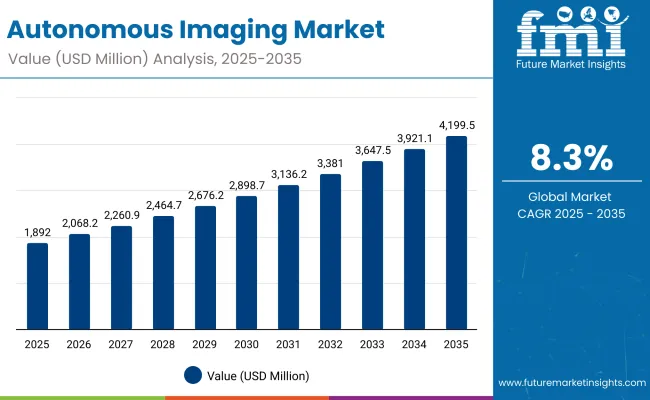
Global Autonomous Imaging Market Key Takeaways
| Metric | Value |
|---|---|
| Global Autonomous Imaging Market Estimated Value in (2025E) | USD 1,892.0 million |
| Global Autonomous Imaging Market Forecast Value in (2035F) | USD 4,199 .5 million |
| Forecast CAGR (2025 to 2035) | 8.3 % |
Between 2025 and 2030, the global autonomous imaging market will see adoption across healthcare, automotive, defense, and industrial inspection as organization rely on imaging systems capable of self-navigation and AI-driven interpretation. It will grow upto USD 926.8 million in that period from USD 1,892.0 million in 2025 to USD 2,818.8 million in 2030.
The combination of edge AI, multimodal sensors, and adaptive imaging algorithms is enhancing the accessibility of autonomous imaging across medical fields such as radiology, oncology, and cardiology. These technologies enable real-time image acquisition, automated anomaly detection, and predictive insights, improving diagnostic accuracy and workflow efficiency.
Between 2030 and 2035, the market is projected to expand further by USD 1,380.8 millionfueled by advances in autonomous surgical imaging, space-based imaging platforms, and AI-enhanced situational awareness systems.
Demand will intensify from sectors such as personalized medicine, where real-time, self-correcting image acquisition is essential for accurate diagnosis, treatment planning, and patient monitoring.Progress in neuromorphic vision sensors, high-speed edge processors, and quantum imaging techniques will define the next wave of autonomous imaging innovations.
From 2020 to 2024, the Global Autonomous Imaging Market, expanded from USD 1216.2 million to USD 1,757.7 million, transitioning from a largely experimental phase into early commercialization. During this period, AI-enabled vision systems, autonomous drones, and robotic imaging platforms matured through partnerships between technology firms, universities, and medical device companies. Streamlined imaging software, improved sensor fusion, and more reliable data interpretation capabilities laid the foundation for scaling autonomous imaging into broader industries.
Looking ahead, the autonomous imaging ecosystem will evolve to incorporate AI-powered anomaly detection, real-time 3D reconstruction, and integration with autonomous robotics and IoT infrastructures. These innovations will shorten deployment cycles, expand cross-sector use cases, and increase operational efficiency positioning autonomous imaging as a core enabling technology for next-generation healthcare, mobility, defense, and industrial ecosystems.
The growth of the global autonomous imaging market is driven by the increasing demand for faster, more accurate, and operator-independent diagnostic solutions across healthcare settings. Unlike traditional imaging modalities, autonomous systems integrate AI-driven analysis, automated image acquisition, and real-time processing, enabling consistent, high-quality imaging with minimal human intervention making them indispensable in modern hospitals, clinics, and remote care facilities.
Over the last decade, the scope of autonomous imaging has expanded beyond conventional radiology. It now plays a critical role in emergency care, outpatient diagnostics, and preventive health screening, allowing clinicians to quickly identify conditions ranging from cardiovascular anomalies to musculoskeletal injuries. As healthcare providers increasingly adopt value-based and patient-centric care models, autonomous imaging solutions are becoming a mandatory component of efficient diagnostic workflows.
Another factor driving market expansion is the shift from fully manual systems to smart, integrated platforms. Vendors such as Arterys and Aidoc turnkey solutions that combine imaging modalities CT, X-ray, MRI, ultrasound, and mammography with AI-assisted workflow management and cloud-based data analysis. This decentralization of expertise allows smaller clinics and remote facilities to achieve hospital-level diagnostic capabilities without extensive specialist intervention.
Moreover, rising adoption in emerging markets, growing geriatric populations, and an increased focus on early disease detection are fueling demand for compact, portable, and multi-modal autonomous imaging systems. Innovations such as low-dose protocols, hybrid imaging, 3D/4D visualization, and automated anomaly detection are further expanding clinical utility, supporting more comprehensive and efficient patient care.
Collectively, these technological, operational, and demographic drivers are positioning the global autonomous imaging market for sustained growth, as healthcare systems worldwide seek to enhance diagnostic efficiency, accessibility, and precision.
The market is segmented by type, device type, deployment type, and end user. By type, it includes semi-autonomous systems and fully autonomous systems, reflecting varying levels of automation in imaging workflows, by device type, segmentation covers X-ray machines, CT scanners, MRI machines, ultrasound systems, mammography systems, and others, representing the broad adoption of autonomous imaging across diagnostic modalities, by deployment type, the market is divided into on-premises, cloud-based, and hybrid models, depending on infrastructure and data management needs, by end user, the segmentation includes hospitals, diagnostic imaging centers, outpatient/ambulatory surgery centers, telemedicine providers, and research institutions, which collectively drive demand for autonomous imaging technologies in both clinical and research settings.
Regionally, the scope spans North America, Latin America, Western and Eastern Europe, East Asia, South Asia and Pacific, and the Middle East and Africa.
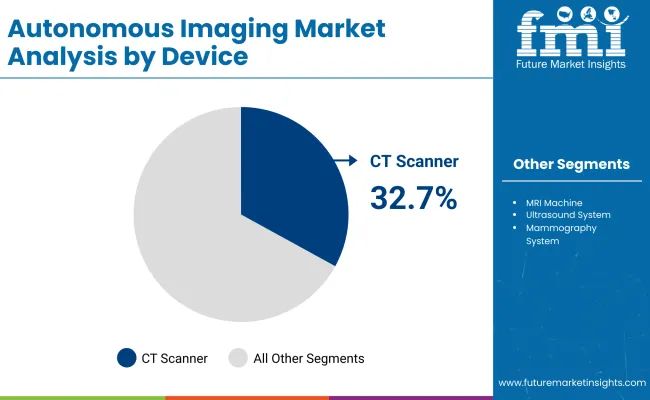
| Device | Market Value Share, 2025 |
|---|---|
| X ray Machine | 21.4% |
| CT Scanner | 32.7% |
| MRI Machine | 17.8% |
| Ultrasound System | 13.8% |
| Mammography System | 6.2% |
| Others | 8.1% |
CT scanners are projected to lead the autonomous imaging market with a 32.7% share in 2025, and are expected to maintain this position due to their ability to deliver high-resolution, volumetric imaging with rapid acquisition times across a wide range of clinical applications. Unlike conventional X-ray systems, CT scanners offer multi-slice detectors, AI-assisted image reconstruction, and dose-optimization technologies allowing clinicians to capture precise anatomical and functional information while minimizing radiation exposure.
Recent advances in photon-counting detectors, iterative reconstruction algorithms, and hybrid imaging integration (such as PET/CT) have enabled these systems to operate with unprecedented speed and diagnostic precision. Moreover, automation in scanning protocols, workflow management, and AI-driven anomaly detection allows healthcare providers to perform complex studies efficiently, supporting early disease detection and detailed anatomical mapping.
A key factor behind their dominance is widespread deployment in hospitals, emergency care units, and diagnostic centers. With commercial vendors offering turnkey solutions that require minimal operator training, CT scanners are becoming increasingly accessible to medium-sized clinics and outpatient facilities. Their combination of throughput, resolution, and automation further positions them as the go-to modality for advanced diagnostic imaging.
As demand for rapid, AI-enhanced, and minimally invasive diagnostics grows, the versatility and precision of CT scanners ensure they remain central to modern clinical imaging, supporting improved patient outcomes and operational efficiency across global healthcare settings.
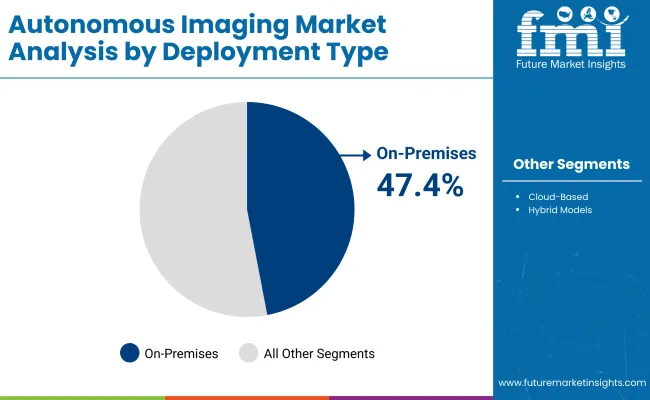
| Deployment Type | Market Value Share, 2025 |
|---|---|
| On-premises | 47.4% |
| Cloud-based | 28.9% |
| Hybrid Models | 23.7% |
On-premises continues to dominate the deployment type in 2025, accounting for 47.4% of total demand. This model remains the backbone of enterprise IT infrastructure due to its proven ability to deliver high control, security, and customization over critical workloads. Organizations with strict data privacy, compliance, and latency requirements continue to favor on-premises solutions, leveraging mature hardware and software ecosystems that have been optimized over decades.
What makes on-premises deployment irreplaceable is its predictability, reliability, and control. IT teams have long-standing expertise in managing on-premises systems, including servers, storage, and networking, and organizations have invested heavily in operational procedures, security protocols, and disaster recovery plans. These investments create a rich foundation for maintaining consistent performance and regulatory compliance. Moreover, enterprise training programs and industry certifications continue to emphasize on-premises best practices, ensuring a sustained pool of skilled professionals.
While cloud-based and hybrid solutions are gaining traction in specific use cases such as remote collaboration, elasticity, and pay-as-you-go models, on-premises deployments remain the mainstay of global enterprise IT, largely due to their versatility, security, and long-term cost predictability.
The adoption of autonomous imaging is accelerating across research laboratories, pharmaceutical companies, and advanced manufacturing facilities as AI, robotics, and imaging technologies converge to enable high-throughput, precise, and reproducible data acquisition. While the market shows strong growth, structural limitations linked to system complexity, cost, and operational requirements remain significant.
Growing Role in High-Precision Imaging and Automation Autonomous imaging is emerging as a critical enabler in materials science, life sciences, and semiconductor research, where precision and reproducibility are essential. These systems allow researchers to conduct high-resolution analyses with minimal human intervention, reducing errors and improving data consistency.
Industries are deploying autonomous imaging platforms to accelerate discovery, validate experimental results, and monitor quality across production processes, addressing the increasing demand for scalable and automated solutions. The integration of AI-driven image analysis further enhances detection accuracy, enabling the identification of subtle variations that may be overlooked in manual assessments.
As automation technologies mature, autonomous imaging is transitioning from a niche capability to a standard tool within experimental validation workflows. This trend is particularly evident in sectors where high throughput and reliability are critical, reinforcing autonomous imaging’s role as a driver of efficiency, innovation, and competitive advantage in the global market.
Shift Toward Compact and Turnkey Autonomous Imaging Solutions A key trend shaping the global autonomous imaging market is the movement away from large, specialized imaging setups toward compact, turnkey systems. Manufacturers are increasingly delivering platforms that integrate high-resolution cameras, robotics, and AI-powered control into a single unit, reducing dependence on complex infrastructure.
These solutions are designed for ease of use, enabling operators with limited technical expertise to perform advanced imaging tasks with precision. Enhancements in environmental control, automated focusing, and software integration have further expanded their applicability across healthcare, research, and industrial sectors.
Countries aiming to strengthen research independence are equipping universities and mid-sized facilities with in-house autonomous imaging solutions, broadening access beyond high-end institutions. This transition is making autonomous imaging more scalable and practical, reflecting a wider trend toward democratizing advanced imaging technologies and positioning them as mainstream tools rather than niche, resource-intensive systems.
High Implementation Costs as a Key Restraint in Autonomous Imaging High implementation costs remain a significant restraint on the adoption of autonomous imaging systems across healthcare, research, and industrial sectors. These systems integrate advanced AI algorithms, robotics, high-resolution sensors, and multimodal imaging technologies, making initial investments substantial. Beyond purchase costs, operational expenses such as routine calibration, software maintenance, and staff training further increase the total cost of ownership.
Smaller hospitals, clinics, and research institutions often face budgetary limitations that hinder procurement and delay deployment. High costs also affect emerging markets, where limited IT infrastructure and financial resources reduce the feasibility of adopting advanced imaging platforms.
Market analyses indicate that these financial barriers are among the primary reasons autonomous imaging systems remain concentrated in well-funded institutions and specialized research centers. Until cost-effective solutions or scalable, modular models become more widely available, high implementation expenses will continue to limit the widespread adoption and integration of autonomous imaging technologies globally.
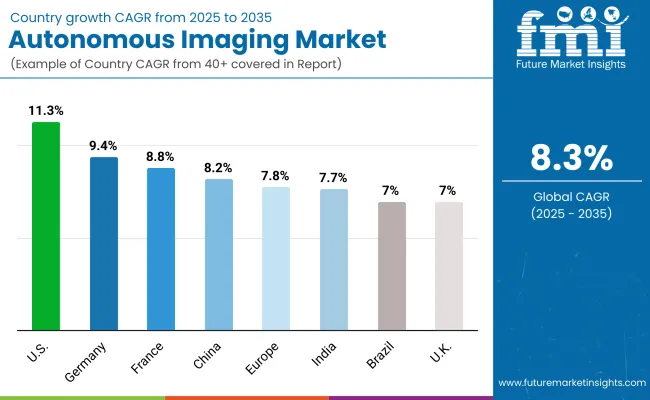
| Country | CAGR |
|---|---|
| USA | 11.3% |
| Brazil | 7.0% |
| China | 8.2% |
| India | 7.7% |
| Europe | 7.8% |
| Germany | 9.4% |
| France | 8.8% |
| UK | 7% |
The adoption and growth patterns of autonomous imaging systems exhibit notable variations across regions, shaped by the maturity of research and industrial infrastructure, government funding, and demand from specialized applications.
In the United States, the autonomous imaging market is driven by a strong ecosystem of academic research labs, technology companies, and industrial players in healthcare sectors. Advanced AI-powered imaging platforms and robotics-enabled systems support high-throughput, precise data acquisition, enabling applications ranging from diagnostic imaging to industrial quality control.
Continuous investments in smart laboratories, automation, and AI integration further accelerate adoption. Favorable government initiatives and collaborations between public research institutions and private enterprises reinforce the development and deployment of autonomous imaging technologies. The market in the USA is projected to account for 11.3% in 2025.
In Europe, countries such as Germany, France, and the UK are at the forefront of the autonomous imaging market, driven by strong research infrastructure, advanced industrial applications, and government-backed innovation initiatives. National programs supporting AI, robotics, and high-precision imaging foster collaborations between academic institutions and private enterprises, enabling the integration of autonomous imaging platforms across healthcare, manufacturing, and defense sectors.
Leading research centers and technology hubs provide access to state-of-the-art laboratory facilities and advanced automation systems, promoting adoption of both compact and integrated imaging solutions. Strategic funding and regulatory support for smart laboratories and AI-enabled technologies further accelerate market growth, although adoption progresses carefully as organizations evaluate the operational complexity and cost-effectiveness of these systems. The market in Germany is projected to account for 9.4%, France 8.8%, and the UK 6.7% of the global autonomous imaging market in 2025.
Overall, the European market demonstrates a balance of technological advancement, institutional investment, and research alignment, illustrating how national priorities, infrastructure availability, and expertise shape adoption patterns for autonomous imaging technologies across the region.
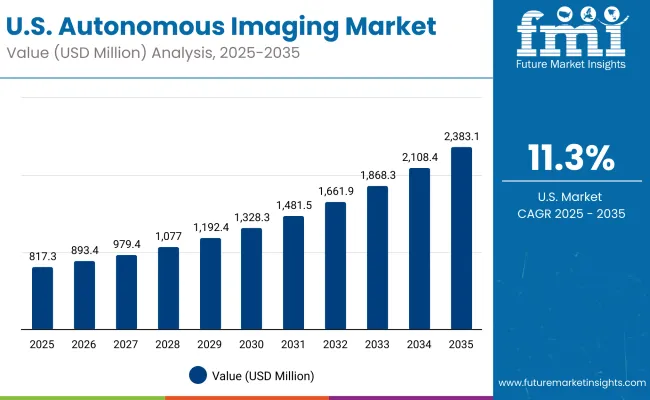
The autonomous imaging market in the United States is projected to account for 11.3% of the global market in 2025. Companies like GE HealthCare, Siemens Healthineers, and Philips are scaling clinical-grade imaging solutions, while cloud and AI players such as Microsoft Azure, Amazon Web Services, and NVIDIA are offering imaging-as-a-service platforms that allow hospitals and research labs to access high-performance analytics without major capital investment.
The autonomous imaging market in India is is projected to expand at a CAGR of 7.7%, driven primarily by premier academic and research institutions, though adoption remains constrained by limited infrastructure and high system costs.
Institutions such as the Indian Institute of Science (IISc), Tata Institute of Fundamental Research (TIFR), and IIT Bombay are pioneering the deployment of autonomous imaging systems in biomedical research, materials characterization, and industrial prototyping. These institutions are integrating AI-enabled imaging platforms with existing laboratory workflows to support high-precision experiments and early-stage industrial applications.
China’s autonomous imaging market is projected to expand at a CAGR of 8.2% between 2025 and 2035, reflecting the country’s rapid investment in AI-driven imaging technologies, autonomous vehicles, smart city infrastructure, and industrial automation.
China has become a hub for applied imaging innovation, with research institutions such as Tsinghua University, Peking University, and the Institute of Physics (Chinese Academy of Sciences) collaborating closely with industrial partners to deploy AI-enabled imaging systems in healthcare. These institutions emphasize translating research into real-world solutions, developing autonomous imaging platforms for medical diagnostics and supporting companies in scaling high-precision imaging technologies for commercial use.
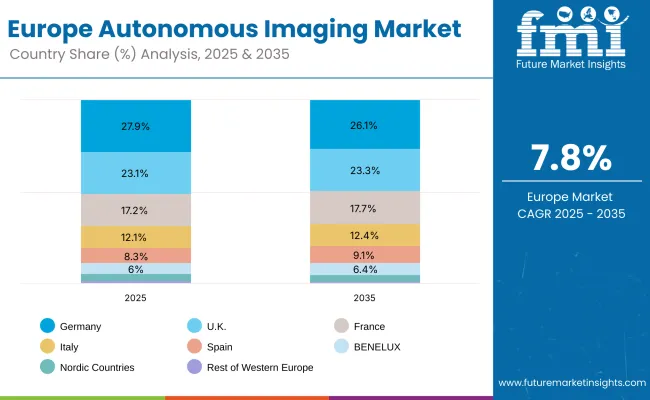
| Europe Country | 2025 |
|---|---|
| Germany | 27.9% |
| UK | 23.1% |
| France | 17.2% |
| Italy | 12.1% |
| Spain | 8.3% |
| BENELUX | 6.0% |
| Nordic Countries | 3.4% |
| Rest of Western Europe | 1.9% |
| Europe Country | 2035 |
|---|---|
| Germany | 26.1% |
| UK | 23.3% |
| France | 17.7% |
| Italy | 12.4% |
| Spain | 9.1% |
| BENELUX | 6.4% |
| Nordic Countries | 4.1% |
| Rest of Western Europe | 1.0% |
The global autonomous imaging market in the United Kingdom is projected to grow at a CAGR of 6.7% between 2025 and 2035. The market is being driven by the deployment of AI-enabled imaging solutions in hospitals, diagnostic centers, and clinical research facilities.
Leading institutions such as the University of Oxford, University of Cambridge, and Imperial College London are collaborating with medical technology companies to implement high-resolution imaging platforms for early disease detection, surgical planning, and patient monitoring.
The country’s well-established healthcare ecosystem supports the integration of autonomous imaging systems with hospital IT networks, electronic health records, and cloud-based analytics, enabling improved diagnostic accuracy, workflow efficiency, and patient outcomes.
There has been a rise in AI-enabled and cloud-connected imaging installations, driven by government innovation funding and participation in pan-European technology initiatives. These systems are increasingly being used in conjunction with automated robotics and real-time data analytics, enabling more comprehensive monitoring, quality control, and diagnostic capabilities across sectors.
The autonomous imaging market in Germany is projected to grow at a CAGR of 9.4% between 2025 and 2035. Germany is establishing itselfas a leading hub for advanced autonomous imaging technologies in healthcare diagnostics. While adoption in research and academia remains strong, the current growth is largely driven by collaborations between technology firms, AI startups, and industrial automation companies.
German companies are strategically developing autonomous imaging subsystems including AI-powered cameras, 3D sensors, and cloud-enabled imaging platforms which are increasingly being integrated into global imaging solutions.
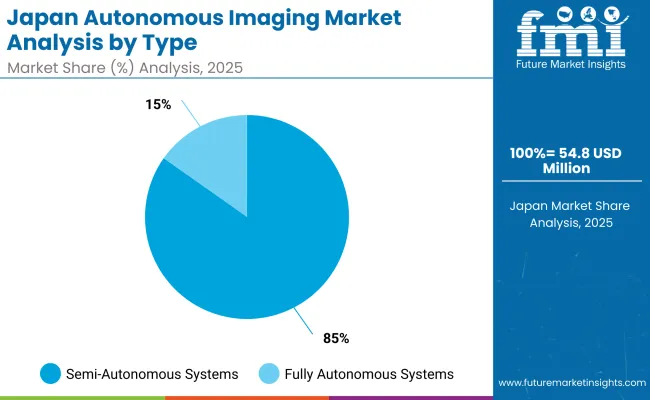
| Type | Market Value Share, 2025 |
|---|---|
| Semi-autonomous Systems | 84.8% |
| Fully Autonomous Systems | 15.2% |
The Global Autonomous Imaging Market in Japan is projected to reach USD 54.87 million by 2025, with semi-autonomous imaging systems leading the product landscape at 84.8% market share, followed by fully autonomous systems at 15.2%. The market is shaped by Japan’s strong tradition in robotics, AI research, and high-resolution imaging technologies.
Companies such as Hitachi Medical Systems, Terumo Corporation, and Nihon Kohden, are deploying autonomous imaging solutions for healthcare applications. Their platforms support AI-assisted diagnostics, real-time patient monitoring, and image-guided interventions.
By combining high-resolution imaging with analytics and hospital IT systems, these companies are improving diagnostic accuracy, enabling predictive healthcare, and supporting personalized treatment planning across hospitals and clinical research facilities.
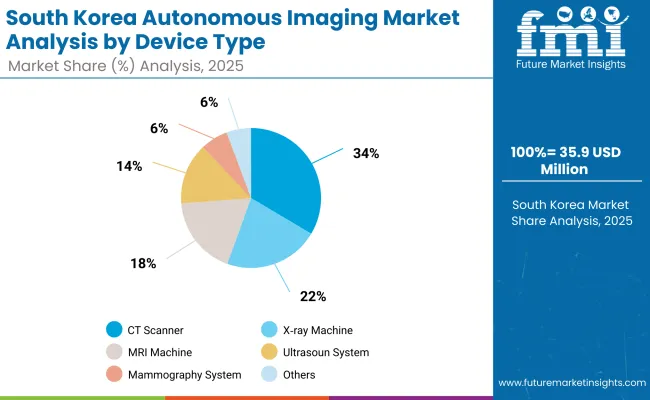
| Device Type | Market Value Share, 2025 |
|---|---|
| X ray Machine | 22.0% |
| CT Scanner | 33.6% |
| MRI Machine | 18.3% |
| Ultrasoun System | 14.2% |
| Mammography System | 6.4% |
| Others | 5.7% |
The global autonomous imaging market in South Korea has been projected to reach USD 35.95 million in 2025. CT Scannerare expected to lead device type with an33.6% followed by X-ray machines at 22.0%.South Korea’s medical imaging market is evolving toward advanced diagnostic and AI-integrated applications. Leading hospitals and diagnostic centers are adopting high-resolution imaging systems combined with AI-assisted analysis to improve diagnostic accuracy, workflow efficiency, and patient outcomes.
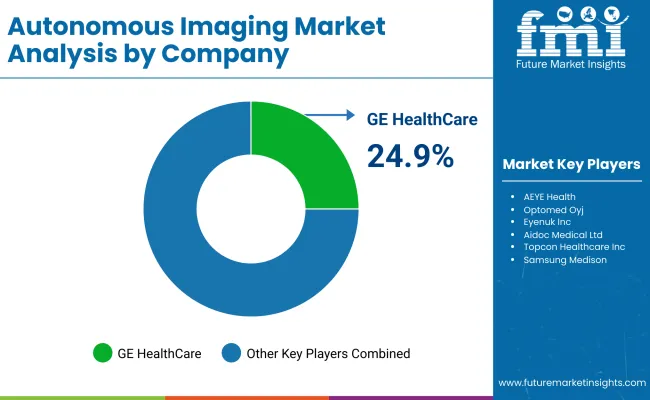
| Company | Global Value Share 2024 |
|---|---|
| GE HealthCare | 24.9% |
| Others | 75.1% |
The Global Autonomous Imaging Market is moderately concentrated, with GE HealthCare holding the largest share at 24.9% in 2024. The company’s leadership is driven by its comprehensive portfolio of autonomous imaging solutions, advanced AI integration, and established global customer base across hospitals and diagnostic centers. GE HealthCare continues to strengthen its position through innovations in imaging automation, cloud-based analytics, and workflow optimization tools.
Other notable players include AEYE Health, OptomedOyj, Eyenuk, Inc., Aidoc Medical Ltd., NIDEK Co., Ltd., Topcon Healthcare, Inc., EchoNous, Bracco Imaging + Subtle Medical, Inc., andSamsung Medison, each targeting specialized segments within the autonomous imaging ecosystem. AEYE Health focuses on autonomous retinal imaging systems, while OptomedOyj provides portable ophthalmic imaging solutions.
Eyenuk and Aidoc leverage AI-driven diagnostic tools for multi-modal imaging. NIDEK, Topcon, and Samsung Medison concentrate on advanced ophthalmic and general imaging devices with AI-assisted capabilities. Bracco Imaging and Subtle Medical integrate AI into imaging contrast and workflow solutions. Collectively, these players account for the remaining 75.1% of the market, reflecting a diverse competitive landscape with multiple specialized offerings.
Key Developments in Global Autonomous Imaging Market
| Item | Value |
|---|---|
| Quantitative Units | USD 1,892.0 million |
| By Type | Semi-autonomous Systems, Fully Autonomous Systems |
| By Device Type | X ray Machine, CT Scanner, MRI Machine, Ultrasound System, Mammography System, Others |
| By Deployment Type | On-premises, Cloud-based, Hybrid Models |
| Regions Covered | North America, Latin America, Western Europe, Eastern Europe, East Asia, South Asia & Pacific, Middle East & Africa |
| Countries Covered | USA, Brazil, China, India, Europe, Germany, France and UK |
| Key Companies Profiled | GE HealthCare, AEYE Health, Optomed Oyj, Eyenuk, Inc., Aidoc Medical Ltd., NIDEK Co., Ltd., Topcon Healthcare, Inc., EchoNous, Bracco Imaging + Subtle Medical, Inc., Samsung Medison |
The global autonomous imaging market is estimated to be valued at USD 1,892.0 million in 2025.
The market size for the global autonomous imaging market is projected to reach approximately USD 4,199.58 million by 2035.
The global autonomous imaging market is expected to grow at a CAGR of 8.3% between 2025 and 2035.
The key types in the Global Autonomous Imaging Market include Semi-autonomous Systems and Fully Autonomous Systems.
In terms of device, CT Scanner is projected to command the highest share at 32.7% in the global autonomous imaging market in 2025.






Our Research Products

The "Full Research Suite" delivers actionable market intel, deep dives on markets or technologies, so clients act faster, cut risk, and unlock growth.

The Leaderboard benchmarks and ranks top vendors, classifying them as Established Leaders, Leading Challengers, or Disruptors & Challengers.

Locates where complements amplify value and substitutes erode it, forecasting net impact by horizon

We deliver granular, decision-grade intel: market sizing, 5-year forecasts, pricing, adoption, usage, revenue, and operational KPIs—plus competitor tracking, regulation, and value chains—across 60 countries broadly.

Spot the shifts before they hit your P&L. We track inflection points, adoption curves, pricing moves, and ecosystem plays to show where demand is heading, why it is changing, and what to do next across high-growth markets and disruptive tech

Real-time reads of user behavior. We track shifting priorities, perceptions of today’s and next-gen services, and provider experience, then pace how fast tech moves from trial to adoption, blending buyer, consumer, and channel inputs with social signals (#WhySwitch, #UX).

Partner with our analyst team to build a custom report designed around your business priorities. From analysing market trends to assessing competitors or crafting bespoke datasets, we tailor insights to your needs.
Supplier Intelligence
Discovery & Profiling
Capacity & Footprint
Performance & Risk
Compliance & Governance
Commercial Readiness
Who Supplies Whom
Scorecards & Shortlists
Playbooks & Docs
Category Intelligence
Definition & Scope
Demand & Use Cases
Cost Drivers
Market Structure
Supply Chain Map
Trade & Policy
Operating Norms
Deliverables
Buyer Intelligence
Account Basics
Spend & Scope
Procurement Model
Vendor Requirements
Terms & Policies
Entry Strategy
Pain Points & Triggers
Outputs
Pricing Analysis
Benchmarks
Trends
Should-Cost
Indexation
Landed Cost
Commercial Terms
Deliverables
Brand Analysis
Positioning & Value Prop
Share & Presence
Customer Evidence
Go-to-Market
Digital & Reputation
Compliance & Trust
KPIs & Gaps
Outputs
Full Research Suite comprises of:
Market outlook & trends analysis
Interviews & case studies
Strategic recommendations
Vendor profiles & capabilities analysis
5-year forecasts
8 regions and 60+ country-level data splits
Market segment data splits
12 months of continuous data updates
DELIVERED AS:
PDF EXCEL ONLINE
Autonomous Driving Simulation Tester Market Size and Share Forecast Outlook 2025 to 2035
Autonomous Aerial Robot Market Size and Share Forecast Outlook 2025 to 2035
Autonomous Driving Virtual Simulation Platform Market Forecast and Outlook 2025 to 2035
Autonomous Ultrasound Guidance Market Analysis - Size, Share, and Forecast Outlook 2025 to 2035
Autonomous AI Powered Ophthalmology Screening Market Size and Share Forecast Outlook 2025 to 2035
Autonomous Radiology Systems Market Size and Share Forecast Outlook 2025 to 2035
Autonomous Agents Market Size and Share Forecast Outlook 2025 to 2035
Autonomous Parking Market Size and Share Forecast Outlook 2025 to 2035
Autonomous Trucks Market Size and Share Forecast Outlook 2025 to 2035
Autonomous Drone Platform Market Size and Share Forecast Outlook 2025 to 2035
Autonomous Mobile Robots for Logistics and Warehousing Market Size and Share Forecast Outlook 2025 to 2035
Autonomous Vehicles Market Growth - Trends & Forecast 2025 to 2035
Autonomous Crane Market Growth - Trends & Forecast 2025 to 2035
Autonomous Forklift Market Growth – Trends & Forecast 2024-2034
Autonomous Robot Toys Market
Autonomous Intelligent Vehicle Market
USA Autonomous Crane Market Analysis – Growth, Trends & Forecast 2025-2035
China Autonomous Crane Market Size and Share Forecast Outlook 2025 to 2035
India Autonomous Crane Market Growth – Innovations, Trends & Forecast 2025-2035
Japan Autonomous Crane Market Report – Growth, Trends & Forecast 2025-2035

Thank you!
You will receive an email from our Business Development Manager. Please be sure to check your SPAM/JUNK folder too.
Chat With
MaRIA